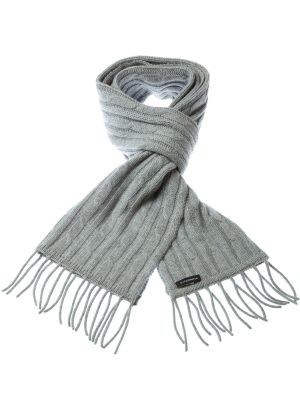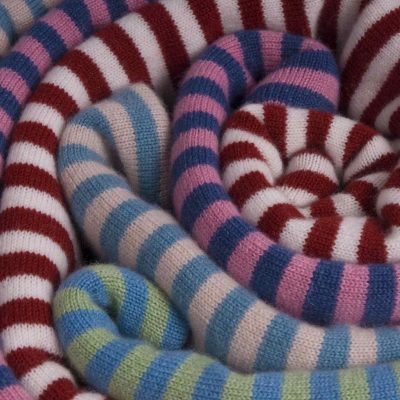Shawl
The shawl is an important and interesting part of human history and culture. In this guide we will take a look at the origins of the shawl, how it is used and some of the many types that are available today.
View our cashmere and silk shawls or our pure cashmere shawls .
The Origins Of The Shawl
A shawl is simply a woven rectangle of fabric. People have been weaving fabrics for a long time.
The earliest evidence found to date comes from fabric imprints in clay which are about 27000 years old. They were found in the Czech Republic. The article didn’t say where, but I am assuming Pavlov.
Pavlov I in southern Moravia is the most complete and complex Gravettian site to date, and a perfect model for a general understanding of Gravettian culture. Gravettian peoples stretched from Russia to Spain from 29000 to 22000 years ago.
A detailed examination of the impressions reveals a large variety of weaving techniques. There are open and closed twines, plain weave and nets. Twining can be done by hand but plain weave needed a loom. A plain weave piece of fabric could have been a shawl. We will get on to how they might have been used later.
It may be that many stone artifacts found in settlements may not be objects of art as had been supposed but parts of an ancient loom, which should now be considered as the first machine to be made after the wheel and aids such as the axe, club, and flint knife.
The academic who studied this claims that the evidence of net making implies that women were catching foxes with them. Seems like a bit of a leap of faith to fit a cultural marxist feminist agenda, but interesting nonetheless.
History and Etymology for Shawl
The word shawl first appeared in English in 1662. I can’t find the exact source of this, but I assume it came in to use due to trade with Persia or India.
The word comes from the From Persian شال (šâl). It is similar to the Sanskrit शाटी (śāṭī). Some sources claim the word originated in the 14th century. The oversimplified version of that story is that a persian man travelled to Ladakh and made a shawl.
It appears that from quite early on, that a shawl was more than just a regular wrap. It was something more prestigious, and linked to higher quality yarns such as cashmere. Wrap was in English since the early 14th century.
Definition of Shawl
Merriam Webster defines shawl as: a square or oblong usually fabric garment or wrapper used especially as a covering for the head or shoulders.
Wikipedia describes a shawl as : A shawl (from Persian: lang-Urdu شال shāl,[1] which may be from Hindi: दुशाला duśālā, ultimately from Sanskrit: शाटी śāṭī[2]) is a simple item of clothing, loosely worn over the shoulders, upper body and arms, and sometimes also over the head. It is usually a rectangular or square piece of cloth, which is often folded to make a triangle, but can also be triangular in shape. Other shapes include oblong shawls.
The cloth can be made from almost any fibre or material. The limit to this is that it should be relatively lightweight. Too thick and it is a blanket.
With regards to size, there is no precise definition. If it is too small it is a cashmere scarf and if it is too big then it would be a throw or blanket.
Types of Shawl
There are many types of shawl. The range of possible materials, designs, sizes, shapes and colours is practically infinite. We will look here at some of the more famous types of shawl.
Embroidered Shawls
Kashmir, in India, is famous for these. However, I have to say that finding a genuine high quality cashmere shawl with genuine silk embroidery is very difficult. Kashmir seems to be full of con men and scammers.
Jacquard Shawls
The jacquard loom was invented by Joseph Marie Jacquard in 1804.The loom was controlled by a “chain of cards”; a number of punched cards laced together into a continuous sequence. The resulting pattern in the fabric of the shawl catches the light and looks amazing. We sell two types of jacquard pashminas.
Cashmere Shawls
Cashmere is often associated with shawls. It is really the ideal material. Soft and light and comfortable against the skin. if you take a shawl on a flight it will keep you warm, but will still pack up small enough to fit in your hand luggage easily.
Ways To Use A Shawl
The primary use for a shawl is to cover and keep warm, but there are a couple more ways they can be used.
- A baby carry sling. This is a common use in Nepal. A 90x200cm shawl works well enough to carry a baby, either on your side on on your back. In my experience, it is not as comfortable as the long baby carrying slings, but it works fine for short periods of time. I wouldn’t do this with a pure cashmere one, but have done it with a pashmina shawl that is 70% cashmere and 30% silk.
- A baby hammock . A hammock is a great place for a baby. It keeps the baby clear of the ground and away from ants. Babies like the rocking motion and find it soothing. A shawl can quickly be turned in to a hammock with some bits of rope tied at the ends. You can hang it under a table. I have done this too 🙂
- As a bag. If it works to carry a baby, think what else you could carry. The advantage is that you can lay it flat, fill it with stuff, then fold it up to close it. I have also done this. I suppose in 17 years of carrying shawls around, occasionally they have to be put to work in the less luxurious ways.
Shawl Manufacturing In The UK
John Kay invented the flying shuttle in 1733. The flying shuttle used in Nepal today to weave a pashmina shawl, looks identical to the one John Kay invented all those years ago.
John Kay was born in 1704 in Lancashire. He apprenticed with a hand-loom reed maker, but is said to have returned home within a month claiming to have mastered the business. He designed a metal substitute for the natural reed that proved popular enough for him to sell throughout England.
He continued to design improvements to textile machinery; in 1730 he patented a cording and twisting machine for worsted.
In 1733, he received a patent for his most revolutionary device: a “wheeled shuttle” for the hand loom. It greatly accelerated weaving, by allowing the shuttle carrying the weft to be passed through the warp threads faster and over a greater width of cloth. It was designed for the broad loom, for which it saved labour over the traditional process, needing only one operator per loom – rather than two.
Kay always called this invention a “wheeled shuttle”, but others used the name “fly-shuttle” (and later, “flying shuttle”) because of its continuous speed, especially when a young worker was using it in a narrow loom. The shuttle was described as travelling at “a speed which cannot be imagined, so great that the shuttle can only be seen like a tiny cloud which disappears the same instant.”
But by September 1733 the Colchester weavers, were so concerned for their livelihoods that they petitioned the King to stop Kay’s inventions.
The flying shuttle was to create a particular imbalance by doubling weaving productivity without changing the rate at which thread could be spun,disrupting spinners and weavers alike. A weaver could now make fabric quicker than a spinner could spin the thread for it.
Also, fly-shuttle use was becoming widespread in weaving, increasing cotton yarn demand and its price – and Kay was blamed.
Suggested Books About The Shawl
Alfrey, Penelope. “The Social Background to the Shawl.” In The Norwich Shawl. Edited by Pamela Clabburn. London: HMSO, 1995.
Clabburn, Pamela, ed. The Norwich Shawl. London: HMSO, 1995.
Journal de la Mode et du Gout. No. 11 (5 June 1790): 1–3.
Lochrie, Maureen. “The Paisley Shawl Industry.” In Scottish Textile History. Edited by John Butt and Kenneth Ponting. Aberdeen, Scotland: Aberdeen University Press, 1987.
Mackrell, Alice. Shawls, Stoles and Scarves. London: B. T. Bats-ford Ltd., 1986.
Morgan, Kenneth O. The Oxford History of Britain. Oxford and New York: Oxford University Press, 1992, 2001.
Pauly, Sarah. The Kashmir Shawl. New Haven, Conn.: Yale University Art Gallery, 1975.
Perrot, Philippe. Fashioning the Bourgeoisie: A History of Clothing in the Nineteenth Century. Princeton, N.J.: Princeton University Press, 1994.


















